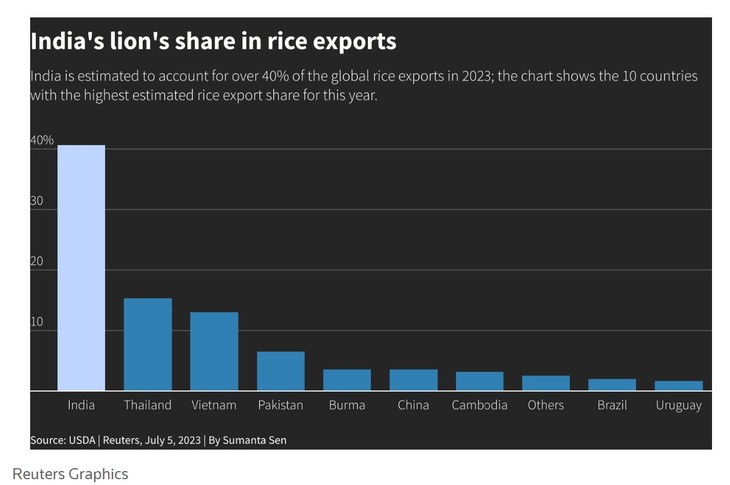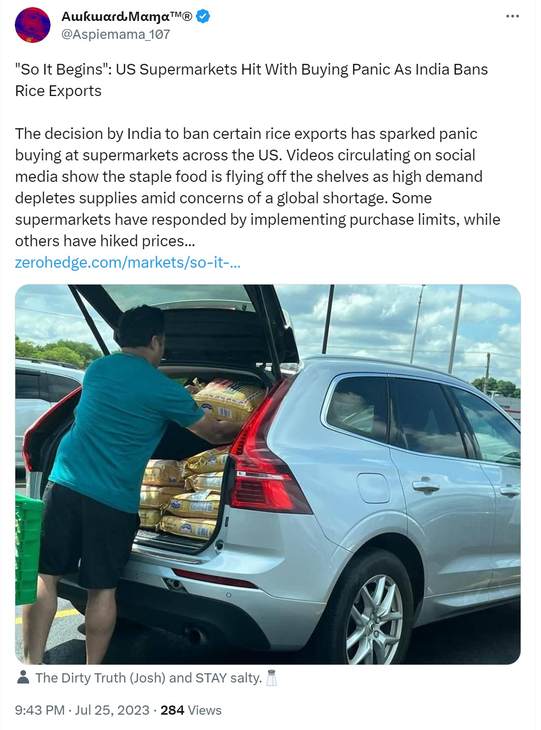Last week, in an effort to combat food price inflation at home – which is running at about 11% – the Indian government made a major move in the international food markets. They banned the export of their largest rice category – non-basmati white rice – hoping to cool prices domestically.
India on Thursday ordered a halt to its largest rice export category in a move that will roughly halve shipments by the world’s largest exporter of the grain, triggering fears of further inflation on global food markets.
The government said it was imposing a ban on non-basmati white rice after retail rice prices climbed 3% in a month after late but heavy monsoon rains caused significant damage to crops.
India accounts for more than 40% of world rice exports, and low inventories with other exporters mean any cut in shipments could inflate food prices already driven up by Russia’s invasion of Ukraine last year and erratic weather.
“In order to ensure adequate availability of non-basmati white rice in the Indian market and to allay the rise in prices in the domestic market, the government of India has amended the export policy,” the food ministry said in a statement that cited a 11.5% increase in retail prices over 12 months.
The ban, which was scheduled to take effect the 20th, takes 10M tons of their total 22M tons of rice exports out of the market almost immediately. Alarm bells were going off instantly, especially in the Asian and African countries who depend on Indian imports to feed their people.
…”India would disrupt the global rice market with far greater velocity than Ukraine did in the wheat market with Russia’s invasion,” B.V. Krishna Rao, president of the Rice Exporters Association told Reuters.
…While Thailand and Vietnam don’t have enough inventories to plug the shortfall, African buyers would be most affected by India’s decision, Rao said, adding that many countries will urge New Delhi to resume shipments. Other top buyers of Indian rice include Benin, Senegal, Ivory Coast, Togo, Guinea, Bangladesh and Nepal.
The Indians really are the 800lb gorilla in the rice trade – no one even comes close, and that hole will be very difficult to plug.

In the week since announcing the ban, governments dependent on Indian rice have been doing some scrambling, attempting to work deals directly with importers, even as buyers frantically look for other sources of the grain. The Indian government did leave wiggle room for government-to-government discussion for export rice deals for countries in dire straits, saying they would still consider “meeting all needs.”
Global rice market set for government deals as India's ban curbs supplies https://t.co/hOuaWmROSu pic.twitter.com/mATHp0QxVg
— Reuters (@Reuters) July 26, 2023
Global rice importers are likely to seek direct deals with governments in exporting countries as India’s ban on shipments of a key variety is squeezing supplies and igniting concerns over food security.
Buyers from Africa to Asia are likely to scramble for rice shipments as supplies tighten in coming months following India’s decision last week to ban non-basmati white rice exports.
The ban will cut availability of the staple on world markets by about a fifth, traders and analysts said, and could lead to importers seeking more government-to-government deals to overcome shortages and tame spiralling prices.
“Export restrictions inherently reduce trust in the dependability of international trade,” said Shirley Mustafa, rice market analyst at the U.N.’s Food and Agriculture Organisation (FAO).
“Thus, they could result in importing countries looking at government-to-government deals to ensure supplies.”
As you’d figure, the price of rice has soared on the news and sparked a hoarding frenzy, even here in the States, where we really wouldn’t be affected by a rice “shortage,” per se. We have plenty of rice – out of California and Louisiana/Texas (our personal favorite). But I guess some folks love their Indian imports and can’t be without them. I mean, I get it.
India’s rice export ban has triggered panic buying at US supermarkets, causing the price of a 20-pound bag to surge from $16 to almost $50 in some stores.
The south Asian country, which accounts for 40 percent of world rice exports, ordered a halt to its largest rice export category, non-basmati rice, on Thursday to calm domestic prices, sparking fears of global shortages.
Videos and reports shared on social media over the weekend show Indian-Americans standing in long lines or panic-buying rice in Texas, Michigan, New Jersey Alabama, Ohio, Illinois and California.
Some stores have hiked the price of a 20-pound bag to $46.99 and have started money-making schemes to capitalize on the panic, according to Business Line.
Meanwhile, in Dallas, thanks to erroneous tweets like this super heating the water…
PANIC AT THE GROCERY STORE
India has banned ALL EXPORTS of rice and we’re seeing people hoard supplies at grocery stores everywhere.
Expect the price of rice to skyrocket over the next few days. If you love rice, it might be worth picking some extra bags up. pic.twitter.com/UjI4WZnXxg
— Dr Danish (@operationdanish) July 24, 2023
WOWSAHS
Good grief – it’s NOT “ALL” EXPORTS for crying out loud. Only white non-basmati rice. Like our American long grain. Feed the panic, dude, why doncha?

Righting the rice ship won’t be that easy, either. As with all things agricultural, cranky weather is playing a part. For the past few years, Indian rice production has been curtailed – again, causing pricing pressures – because the shallow easterlies and sub-tropical jet that normally slip under the Himalayas down into the plains (where their most fertile rice production occurs,) and bring the rains that fill the paddies have, instead, been riding the ridge of the mountains up and around. They then dump that massive amount of moisture into Northeastern India and Bangladesh, while leaving central India’s rice bowl drought-stricken.
India’s food secretary today affirmed the declining rice output trend in the country that had pushed New Delhi to put restrictions on the export of the foodgrain even at the cost of likely stoking food inflation across several nations.
Rice production in the 2022-2023 crop year could fall by 7-8 million tonnes because of drought, or even 12 million tonnes in a worst-case scenario, Food Secretary Sudhanshu Pandey said.
Conversely, in the northern states like Punjab, they are suddenly deluged and the paddies are flooded.
…But heavy rain in the north of India over the last few weeks has damaged newly-planted crops in Punjab and Haryana states.
Paddy fields have been submerged for over a week, destroying seedlings, and forcing farmers to wait before they can replant the rice seeds.
In other major rice-growing states, farmers have prepared paddy nurseries but have been unable to transplant the seedlings due to inadequate rainfall.
The area under rice cultivation had been expected to increase after New Delhi raised the rice purchase price, but farmers so far have planted rice paddy on an area 6 percent smaller than in 2022.
Sugar cane yields have also dropped, and now there is concern regarding the coming effects of the growing El Niño.
Vietnam has seen prices spike for their rice, which is also due to the fact that they don’t produce enough to provide what India is withdrawing from the market. It’s going to be very interesting to see how China, whose economy is already being buffeted by tremendous inflationary pressures, handles this latest economic shock.
…This week, prices of rice exported from Vietnam, the world’s third-largest exporter after India and Thailand, soared to their highest in more than a decade on growing supply concerns due to El Nino.
Vietnam’s 5 percent broken rice was offered at $515-$525 per metric ton – its highest since 2011. India’s 5 percent broken parboiled variety hovered near a five-year peak at $421-$428 per metric ton.
Buyers may move to Thailand and Vietnam, but their 5 percent broken rice could cost $600 per metric ton, said one European trader.
China and the Philippines, who generally buy Vietnamese and Thai rice, will be forced to pay substantially higher prices, another European dealer said.
As for American rice producers, they’re looking at India with a slightly jaundiced view…
India says its latest ban on rice exports is an effort to fight domestic food inflation, but the U.S. rice sector says the measure will add large quantities of cheap grain to the international market and push down prices that American farmers get for their crop.
The Indian ban on long grain rice – excluding basmati and parboiled – will likely help U.S. rice exporters in the short term by driving up global prices, USA Rice Federation Vice President of Policy and Government Affairs Peter Bachmann tells Agri-Pulse, but the situation will eventually reverse when India sells its hoarded stocks on the international market.
“This is just another example of India playing games with global food security, citing concerns over domestic supplies despite tens of millions of metric tons in government stocks in addition to what’s stored privately,” said Bobby Hanks, chair of the USA Rice Federation’s International Trade Policy Committee. “With this action, India can quickly build more stocks that they’ll eventually dump back on the world market at dirt cheap prices and continue this cycle again.”
…after watching this cycle play itself out a few times before.
We love our American Texas/Louisiana rice, so can thankfully mark ourselves “safe” from having to rice shop in Dallas.
And I’ve already got my hurricane stocks set in, so any price increases domestically because of this won’t hit me ’til next year.
But, man – lately it’s always something, no?








Join the conversation as a VIP Member